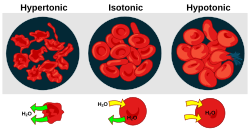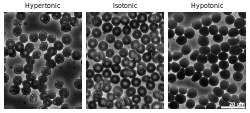Osmotic pressure: Difference between revisions
No edit summary |
|||
| Line 8: | Line 8: | ||
The phenomenon of osmotic pressure arises from the tendency of a pure solvent to move through a semi-permeable membrane and into a solution containing a solute to which the membrane is [[Permeability (earth sciences)|impermeable]]. This process is of vital importance in biology as the cell's [[Biological membrane|membrane]] is selective toward many of the solutes found in living organisms. |
The phenomenon of osmotic pressure arises from the tendency of a pure solvent to move through a semi-permeable membrane and into a solution containing a solute to which the membrane is [[Permeability (earth sciences)|impermeable]]. This process is of vital importance in biology as the cell's [[Biological membrane|membrane]] is selective toward many of the solutes found in living organisms. |
||
In order to visualize this effect, imagine a U-shaped clear tube with equal amounts of water on each side, separated by a membrane at its base that is impermeable to sugar molecules (made from [[dialysis tubing]]). Sugar has been added to the water on one side. The height of the water on each side will change proportional to the [[pressure]] of the solutions. Osmotic pressure causes the height of the water in the compartment containing the sugar to rise, due to movement of the pure water from the compartment without sugar into the compartment containing the sugar water. This process will stop once the pressures of the water and sugar water toward both sides of the membrane |
In order to visualize this effect, imagine a U-shaped clear tube with equal amounts of water on each side, separated by a membrane at its base that is impermeable to sugar molecules (made from [[dialysis tubing]]). Sugar has been added to the water on one side. The height of the water on each side will change proportional to the [[pressure]] of the solutions. Osmotic pressure causes the height of the water in the compartment containing the sugar to rise, due to movement of the pure water from the compartment without sugar into the compartment containing the sugar water. This process will stop once the pressures of the water and sugar water toward both sides of the membrane become equal (see [[osmosis]]). |
||
[[Jacobus Henricus van 't Hoff]] first proposed a formula for calculating the osmotic pressure, but this was later improved upon by [[Harmon Northrop Morse]].{{Citation needed|date=July 2009}} |
[[Jacobus Henricus van 't Hoff]] first proposed a formula for calculating the osmotic pressure, but this was later improved upon by [[Harmon Northrop Morse]].{{Citation needed|date=July 2009}} |
||
| Line 20: | Line 20: | ||
where <math>p</math> denotes the external pressure, <math>l</math> the solvent, <math>x_s</math> the mole fraction of the solvent and <math>\Pi</math> the osmotic pressure exerted by the solutes. The addition of solute decreases the chemical potential (an [[entropy|entropic effect]]), while the pressure increases the chemical potential, and thus a balance is reached. |
where <math>p</math> denotes the external pressure, <math>l</math> the solvent, <math>x_s</math> the mole fraction of the solvent and <math>\Pi</math> the osmotic pressure exerted by the solutes. The addition of solute decreases the chemical potential (an [[entropy|entropic effect]]), while the pressure increases the chemical potential, and thus a balance is reached. |
||
Note that the presence of the solute decreases the potential |
Note that the presence of the solute decreases the potential because <math>x_s</math> is smaller than 1. |
||
=== Derivation of osmotic pressure === |
=== Derivation of osmotic pressure === |
||
Revision as of 13:27, 3 June 2014
This article needs additional citations for verification. (September 2011) |


Osmotic pressure is the pressure which needs to be applied to a solution to prevent the inward flow of water across a semipermeable membrane.[1] It is also defined as the minimum pressure needed to nullify osmosis.
The phenomenon of osmotic pressure arises from the tendency of a pure solvent to move through a semi-permeable membrane and into a solution containing a solute to which the membrane is impermeable. This process is of vital importance in biology as the cell's membrane is selective toward many of the solutes found in living organisms.
In order to visualize this effect, imagine a U-shaped clear tube with equal amounts of water on each side, separated by a membrane at its base that is impermeable to sugar molecules (made from dialysis tubing). Sugar has been added to the water on one side. The height of the water on each side will change proportional to the pressure of the solutions. Osmotic pressure causes the height of the water in the compartment containing the sugar to rise, due to movement of the pure water from the compartment without sugar into the compartment containing the sugar water. This process will stop once the pressures of the water and sugar water toward both sides of the membrane become equal (see osmosis).
Jacobus Henricus van 't Hoff first proposed a formula for calculating the osmotic pressure, but this was later improved upon by Harmon Northrop Morse.[citation needed]
Theory
Thermodynamic explanation
Consider the system at the point it has reached equilibrium. The condition for this is that the chemical potential of the solvent (since only it is free to flow toward equilibrium) on both sides of the membrane is equal. The compartment containing the pure solvent has a chemical potential of . On the other side, the compartment containing the solute has an additional contribution from the solute (factored as the mole fraction of the solvent, < 1) but there also appears an addition in pressure. The balance is therefore:
where denotes the external pressure, the solvent, the mole fraction of the solvent and the osmotic pressure exerted by the solutes. The addition of solute decreases the chemical potential (an entropic effect), while the pressure increases the chemical potential, and thus a balance is reached. Note that the presence of the solute decreases the potential because is smaller than 1.
Derivation of osmotic pressure
In order to find , the osmotic pressure, we consider equilibrium between a solution containing solute and pure water.
We can write the left hand side as:
where is the activity coefficient of the solvent. The product is also known as the activity of the solvent, which for water is the water activity . The addition to the pressure is expressed through the expression for the energy of expansion:
where is the molar volume (m³/mol). Inserting the expression presented above into the chemical potential equation for the entire system and rearranging will arrive at:
If the liquid is incompressible the molar volume is constant and the integral becomes . Hence we can get an equation with high accuracy
For pure substances the activity coefficient can be found as a function of concentration and temperature, but in the case of mixtures we are often forced to assume it is 1.0, so
For aqueous solutions, when determining the mole fraction of water, it is necessary to take into account the ionisation of salts. For example 1 mole of NaCl ionises to 2 moles of ions, and the mole fraction of water reduces accordingly.
Historically chemists have found it time consuming to calculate natural logs, so they used molal concentrations for dilute solutions as shown below. With spreadsheets the equations above are easy to use and offer much greater accuracy over a wider range of concentrations.
Morse equation
The osmotic pressure Π of an ideal solution with low concentration can be approximated using the Morse equation (named after Harmon Northrop Morse):[2]
- ,
where
- i is the dimensionless van 't Hoff factor
- M is the molarity
- R=.08205746 L atm K-1 mol-1 is the gas constant
- T is the thermodynamic (absolute) temperature
This equation gives the pressure on one side of the membrane; the total pressure on the membrane is given by the difference between the pressures on the two sides. Note the similarity of the above formula to the ideal gas law and also that osmotic pressure is not dependent on particle charge. This equation was derived by van 't Hoff.
Tonicity
Osmotic pressure is an important factor affecting cells. Osmoregulation is the homeostasis mechanism of an organism to reach balance in osmotic pressure.
- Hypertonicity is the presence of a solution that causes cells to shrink.
- Hypotonicity is the presence of a solution that causes cells to swell.
- Isotonicity is the presence of a solution that produces no change in cell volume.
When a biological cell is in a hypotonic environment, the cell interior accumulates water, water flows across the cell membrane into the cell, causing it to expand. In plant cells, the cell wall restricts the expansion, resulting in pressure on the cell wall from within called turgor pressure.
Applications
Osmotic pressure is the basis of filtering ("reverse osmosis"), a process commonly used to purify water. The water to be purified is placed in a chamber and put under an amount of pressure greater than the osmotic pressure exerted by the water and the solutes dissolved in it. Part of the chamber opens to a differentially permeable membrane that lets water molecules through, but not the solute particles. The osmotic pressure of ocean water is about 27 atm. Reverse osmosis desalinates fresh water from ocean salt water.
Osmotic pressure is necessary for many plant functions. It is the resulting turgor pressure on the cell wall that allows herbaceous plants to stand upright, and how plants regulate the aperture of their stomata. In animal cells which lack a cell wall however, excessive osmotic pressure can result in cytolysis.
For the calculation of molecular weight by using colligative properties, osmotic pressure is the most preferred property.
Potential osmotic pressure
Potential osmotic pressure is the maximum osmotic pressure that could develop in a solution if it were separated from distilled water by a selectively permeable membrane. It is the number of solute particles in a unit volume of the solution that directly determines its potential osmotic pressure. If one waits for equilibrium, osmotic pressure reaches potential osmotic pressure.
Additional images
-
Isotonic Solution
-
Hypotonic Solution
-
Hypertonic Solution
See also
References
- ^ Voet, Donald (2001). Fundamentals of Biochemistry (Rev. ed.). New York: Wiley. p. 30. ISBN 978-0-471-41759-0.
{{cite book}}: Unknown parameter|coauthors=ignored (|author=suggested) (help) - ^ Applied Physical Pharmacy. McGraw-Hill Professional. 2002. pp. 54–57. ISBN 0-07-135076-4.
{{cite book}}: Unknown parameter|authors=ignored (help)





















